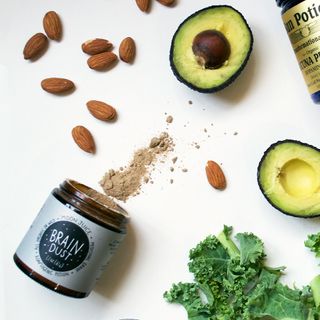I Asked 3 (Very) Different Experts to Analyze My Favorite "Healthy" Breakfast

Some people have a general routine they like to stick to in the morning. For me, it's practically gospel: Between the hours of 7 a.m. and 12 p.m., I am the most habitual of creatures. I get up at the same exact time every day (to the point that I no longer need an alarm because my body just knows), and I flow through the same set of self-care rituals to ease me into my day. And for the past few years, barring travel, eating out, or other extenuating circumstances, I've had the same smoothie for breakfast—every single morning.
I'm not even entirely sure how this came to be, especially since I typically love variety in the foods I eat. My favorite smoothie is tasty, if not particularly life-changing. It's simple; it always kick-starts my digestion and helps me start my day on an energized note. It almost always keeps me full until lunch. But I'd guess its staying power has mostly to do with the fact that it's yet another morning ritual that has become second-nature to me at this point. I barely even have to think about it when I'm shopping for groceries—the ingredients practically land in my cart of their own accord.
But it occurred to me recently that while on paper, my smoothie has all the components of a highly nutritious, well-rounded breakfast, perhaps it could stand to be vetted by an actual professional. So I decided to call on three: In the interest of having a very well-rounded analysis, I sent my recipe to a nutritionist, a hormone expert, and an Ayurvedic practitioner to get their thoughts. Spoiler: I really need to switch things up. (But you were already thinking that, right?)

The smoothie
- 1 1/2 cups frozen spinach or kale
- 1 cup frozen berries
- 1/4 avocado
- 3 tbsp. Nutiva's Hemp Protein Powder ($11)
- 1 tsp. Spirulina Pacifica powder
- 1 tsp. adaptogenic herbs (Sun Potion's Ashwaghanda, $37, or Moon Juice's Power Dust, $38)
- A pinch of cinnamon
- Almond milk (as much as needed)
This combo typically makes for a (very) large smoothie that keeps me energized and full until lunch time.
The Nutritionist's Take
For my first expert opinion, I deferred to NYC-based nutritionist Amy Shapiro. For some reason, I was expecting the worst, but her opinion was unequivocally the most positive response I'd receive. "I really don't have anything bad to say about your smoothie," she responded via email. "It really has it all: veg, fiber, fruit, antioxidants, greens, and adaptogens."
When I pressed her for any tweaks she might make, she suggested maybe switching up my pathetically monotonous breakfast once and a while (my words, not hers). "That way, you ensure you are receiving a variety of nutrients on different days," she explained. This might involve swapping in different veggies, as well as different fat sources: I could opt for flax, chia seeds, or nut butters over my usual avocado, for example.
And while my use of cinnamon got a thumbs up for balancing blood sugar levels, Shapiro also suggested trying turmeric or ginger for anti-inflammation. "They add flavor without added sugar and lots of health benefits too," she said.
The hormone specialist's take
Next up was Alisa Vitti—functional nutritionist, women's hormone expert, and founder of the Flo Living hormone center. Her opinion gave me the most trepidation because if I've learned anything about hormones in my years writing about wellness, it's that they comprise an infuriatingly delicate system and just about anything can send them out of whack. (Ah, the joys of womanhood.)
Sure enough, Vitti had a lot of constructive criticism to offer. Like Shapiro, she didn't think it was wise to have the same thing to eat every single morning, though her reasoning had less to do with switching up my nutrients than eating in tandem with my hormone cycle. "Here you are being so good, making your healthy smoothie with hemp protein," she said. "But by doing it the same way each and every day, you're potentially causing some imbalances in your system."
She went on to explain that most female cycles are composed of four stages, and that ideally, we eat in a way that complements each phase—this keeps our hormones balanced and can help stave off symptoms like bad cramps and mood swings. In my case, however, this is further complicated by the fact that I have an IUD. "Because you’re on low-dose synthetic hormones, you’re technically not having four stages of your cycle," Vitti explained. "You’re just sort of having one continuous hormonal pattern. Birth control basically mimics pregnancy, where you have a decent dose of progesterone to match estrogen." Basically, because my menstrual cycle is already in a perpetually stagnant state, an equally stagnant breakfast might only aggravate my system.
That's not even to mention that I had the specific ingredients all wrong—namely, that they're typically "cooling" ingredients. "In the first half of the cycle, you can have more cooling foods because the body is producing more estrogen and your body is technically warmer," she explained. "And having more raw foods in the first half of the cycle is beneficial because it helps you flush all that excess estrogen." But for women in the second half of their cycles (or on synthetic hormones, like me), the aim is to warm up their reproductive systems and help support progesterone production.
So if I was going to insist on having a smoothie every morning, Vitti said, I'd at the very least need to switch up the ingredients to more fiery, warming foods. That might be as simple as cooking the spinach before tossing it in my blender or swapping out berries for a sweet potato or pumpkin. She also recommended adding warming spices like cinnamon, ginger, or cayenne pepper.
Before closing our (very) enlightening conversation, Vitti had one last note regarding my use of adaptogens. "They need to be handled with care," she explained, adding that while many people consider these powerful herbs to be one-size-fits-all, most of them should be used symptomatically. (They are technically plant medicine, after all.) Instead of using my ashwagandha or Moon Juice dusts on the daily, Vitti suggested reserving them for certain symptoms and swapping in maca instead, which can be used more universally.
The Ayurveda specialist's take
In the interest of getting an entirely holistic POV, I turned to Martha Soffer, an Ayurveda expert at Los Angeles' Surya Spa. Like Vitti, she immediately took issue with the temperature of my morning meal. "You need agni, or fire, to be able to digest your food," she said. "So in general, it's best to avoid frozen or cold drinks because it will slow down digestion and aggravate the vata in your stomach." (For Ayurveda newbies, vata is a physiological and energy "type." There are three of these types, also called doshas, and ideally, you want to keep them balanced in your system at all times.)
"To have very good digestion and elimination, it is very important to consider the quality and the freshness of the food," Soffer added. I did get bonus points for opting for almond milk—apparently combining dairy and fruit in Ayurveda is a big no-no. (In all fairness, I am vegan, so this is a non-issue for me.)
Soffer did leave me with a smoothie recipe that, coincidentally enough, seemed to embody many of the suggestions that Vitti and Shapiro offered as well: Comprised of raw coconut meat, coconut water, and a blend of warming spices like ginger, cardamom, cinnamon, cloves and turmeric, it's a "warming" option to try before actually diving into the brave new world of warm smoothies. (At what point is it just glorified baby food?)
Most importantly, it's incredibly satisfying and quite delicious—and for the first time since I don't know when, I have a new smoothie in rotation. Look out, I'm well on my way to being only slightly less boring.
Next up: Check out the six things a wellness influencer keeps in her bag at all times.
Disclaimer
This article is provided for informational purposes only and is not intended to be used in the place of advice of your physician or other medical professionals. You should always consult with your doctor or healthcare provider first with any health-related questions.

